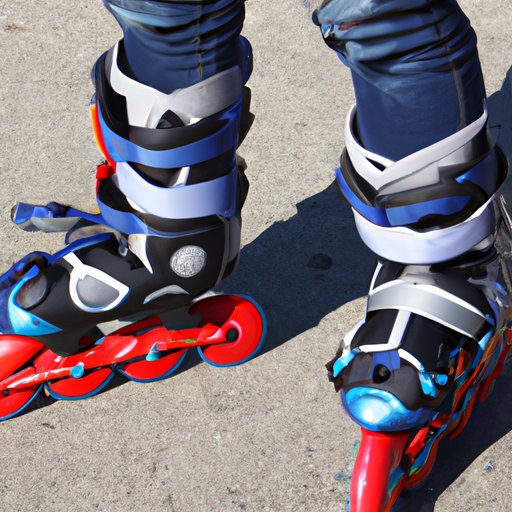
I. Introduction
Roller skating is a fun activity that can be enjoyed by people of all ages. This article aims to provide beginners with the fundamentals of the sport to get them rolling.
II. List of Basic Techniques
Before getting started on wheels, it’s important to learn some fundamental techniques. These basics will set the foundation for more advanced moves. First, start with standing. Keep your feet shoulder-width apart and slightly bend your knees to find your balance. To move forward, step one foot in front of the other, push the back foot off, and repeat.
Turning on skates can be a bit tricky. Start by placing more weight on the foot that’s leading the turn and slightly bending the knee. The other foot should follow, and the turn will occur. Lean your body slightly in the direction of the turn. To stop while rolling forward, drag the dominant foot or both feet parallel to one another in a V-shape. For skating backward, start with standing on your skates, then push off with one foot and keep the other one slightly behind to maintain balance. Don’t forget to balance your weight evenly between your feet.
III. Safety Tips
Safety should always be a top priority when skating. Protective gear is essential and should include a helmet, wrist guards, knee pads, and elbow pads. Having proper posture is also critical. Keep your head up, shoulders back, knees slightly bent, and core engaged to help improve balance.
If you do take a spill, try to roll with the fall and avoid putting your hands out to brace yourself, which could result in wrist injuries. When falling, keep your arms tucked to your chest to avoid any potential injury or breakage. And remember, it’s okay to fall – it’s a natural part of learning to skate.
IV. Best Places to Skate
Choosing the right place to skate is critical for beginners and seasoned roller skaters alike. Parks, parking lots, and skating rinks are excellent options. When picking a location, pay attention to the surface. Smooth pavement is preferred, and gravel should be avoided. Be cautious of traffic and watch out for obstacles that may cause you to lose your balance or fall. Wear bright or reflective clothing to help motorists spot you on the road if you plan to skate in an area where there are cars.
V. Skating Gear
It’s essential to have the appropriate gear when skating, especially if you’re a beginner. A good pair of skates is critical. You can opt for quad skates or inline skates. Quad skates are easier to balance and are preferred by many beginners. They come with four wheels, two in front and two in the back, making them ideal for indoor skating and dancing. Inline skates come with four to five wheels in a line and are best for outdoor skating, speed, and agility. Inline skates demand more balance and skill, which can be challenging for beginners.
Protective gear like helmets, wrist guards, elbow pads, and knee pads are essential to prevent injuries, particularly if you’re a novice. Wear comfortable clothes that allow for ease of movement, like athletic shorts or leggings or bike pants. Avoid loose clothing as it can catch on wheels and cause falls. Choose breathable, synthetic materials that can wick moisture away from the skin, especially when skating in warm environments.
VI. Overcoming Fear
Roller skating can be intimidating for beginners, but it’s an excellent way to boost confidence and remain active. It’s normal to feel scared or anxious, but don’t let it stop you from trying. Start by practicing in a secure and quiet area. Begin with small tasks, such as standing or pushing off from a wall. Don’t be discouraged if you stumble and fall a few times – it’s part of the learning process. Skate at your own pace and gradually build up speed, movement, and agility.
VII. Choosing the Right Skates
Choosing the right skates can be challenging for a novice. Quad skates have four wheels and are perfect for beginners due to their high stability and balance. Inline skates are ideal for outdoor activities and provide greater control over an individual’s speed and movement. They may take some time to master but are worth it if you’re looking to make a more substantial investment in roller skating. Make sure to choose skates that fit correctly and are comfortable.
VIII. Conclusion
Roller skating is an enjoyable activity that requires practice and patience. It’s crucial to follow the basics, such as correct posture and protective gear. It’s also essential to choose the right location and gear for the type of skating you’re looking to do. Don’t be afraid to fall or take your time mastering the fundamental skills.




